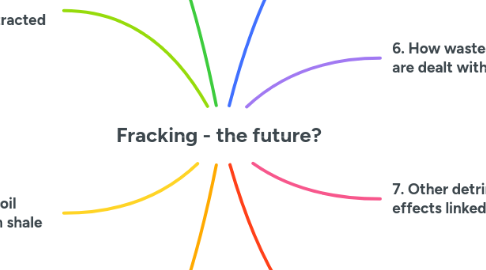Fracking - the future?
Na Phan Lêにより


1. 1. The countries lead the drive toward renewables.
1.1. Costa Rica: 99% of electrical energy are from renewable energy sources in 2014
1.2. Denmark: 42% of electricity from wind turbines in 2015
1.3. Scottish: 100% electricity from renewables by 2020
1.4. US, Russia: being reliant on oil and natural gas
2. 2. How oil & natural gas is traditionally extracted
2.1. Oil + natural gas - found in porous rock formations (reservoirs)
2.2. To extract:
2.2.1. a deep vertical well is drilled through the thick rock --> reservoir
2.2.2. oil + natural gas is pumped back to the surface
3. 3. How to extract oil & natural gas from shale
3.1. Deep vertical wells are drilled down to the level of the shale until reaching the desired depth.
3.2. The drill takes a 90-degree turn and continues horizontally, parallel to the layer of shale rock.
3.3. Small holes then appear along the horizontal section.
3.4. A high-pressure fracking solution is pumped into the surrounding rock for 72 hours.
3.5. The cracks widening allow the oil and natural gas to be released.
4. 4. The claims made by proponents
4.1. Economy
4.1.1. Reducing dependence on foreign energy sources
4.1.2. Providing new sources of income & new jobs
4.1.3. Lowering gas and electricity bills
4.2. Environment
4.2.1. Producing 3 times less carbon emissions than coal
5. 5. The impact of fracking on drinking water
5.1. A large number of additives pumped into the ground -> 2% of the fracking mixture, resulting in:
5.1.1. Leaching into the solid or groundwater
5.1.2. Affecting food production
5.1.3. Contaminating the supply of safe drinking water in the area
